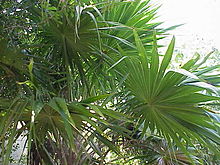| Thrinax | |
|---|---|
 | |
| Thrinax radiata | |
| Scientific classification | |
| Kingdom: | Plantae |
| Clade: | Tracheophytes |
| Clade: | Angiosperms |
| Clade: | Monocots |
| Clade: | Commelinids |
| Order: | Arecales |
| Family: | Arecaceae |
| Subfamily: | Coryphoideae |
| Tribe: | Cryosophileae |
| Genus: | Thrinax L.f. ex Sw. |
| Species | |
| Synonyms [1] | |
Thrinax is a genus in the palm family, native to the Caribbean. It is closely related to the genera Coccothrinax , Hemithrinax and Zombia . [2] Flowers are small, bisexual and are borne on small stalks.



